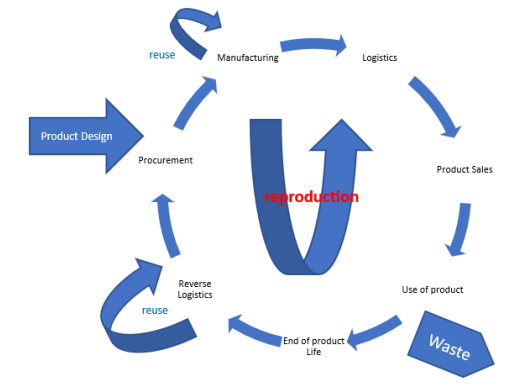Comprehensive Study on the Supply Chain of Vacuum Thermal Cracking System for Sustainable Development: A Case of Waste-to-Energy and Resource Recovery
Main Article Content
บทคัดย่อ
The purpose of this study is to explore the possibility of applying a new technology, vacuum heating technology, to waste-to-energy and resources, and to explore the completeness and feasibility of its supply chain system. First, we'll take a closer look at the implications of vacuum heating technology and its past experience. Second, we will explore ways to convert waste into energy and resources, with a focus on the potential of this technology for sustainable development. Taking Taiwan as a case study, the results of this study show that the vacuum thermal decomposition system can be successfully applied to the recycling and reuse process of agricultural waste, and then generate a generator built into the system, and use the thermal structure to form the final production process. This not only results in the generation of four high-value goods, but also significantly increases the value of the entire system. From a sustainability perspective, such systems have the potential to have a positive impact and can play a positive role in promoting clean energy and resource recycling. However, in the process of promotion, there are still some challenges in supply chain management and the promotion of raw material markets. Successful promotion relies on the efforts of the operator, including
active participation in the establishment and promotion of the supply chain, to ensure the viability and sustainability of the system. This study provides insight into the potential of vacuum heating technology in the field of waste treatment and energy recovery and provides a preliminary discussion of the feasibility study.
Article Details

อนุญาตภายใต้เงื่อนไข Creative Commons Attribution-NonCommercial-NoDerivatives 4.0 International License.
บทความนี้ได้รับการเผยแพร่ภายใต้สัญญาอนุญาต Creative Commons Attribution-NonCommercial-NoDerivatives 4.0 International (CC BY-NC-ND 4.0) ซึ่งอนุญาตให้ผู้อื่นสามารถแชร์บทความได้โดยให้เครดิตผู้เขียนและห้ามนำไปใช้เพื่อการค้าหรือดัดแปลง หากต้องการใช้งานซ้ำในลักษณะอื่น ๆ หรือการเผยแพร่ซ้ำ จำเป็นต้องได้รับอนุญาตจากวารสารเอกสารอ้างอิง
Barth, J. O., Jentys, A., & Lercher, J. A. (2004). Elementary reactions and intermediate species formed during the oxidative regeneration of spent fluid catalytic cracking catalysts. Industrial & engineering chemistry research, 43(12), 3097-3104.
Bishoge, O. K., Huang, X., Zhang, L., Ma, H., & Danyo, C. (2 0 1 9 ). The adaptation of waste-to-energy technologies: Towards the conversion of municipal solid waste into a renewable energy resource. Environmental Reviews, 27(4), 435-446.
Cao, N., Darmstadt, H., & Roy, C. (2 0 0 1 ). Activated carbon produced from charcoal obtained by vacuum pyrolysis of softwood bark residues. Energy & fuels, 15(5), 1263-1269.
Cox, A. (1 9 9 9 ). Power, value and supply chain management. Supply chain management: An international journal, 4(4), 167-175.
Hameed, Z., Aslam, M., Khan, Z., Maqsood, K., Atabani, A. E., Ghauri, M., & Nizami, A. S. (2021). Gasification of municipal solid waste blends with biomass for energy production and resources recovery: Current status, hybrid technologies and innovative prospects. Renewable and Sustainable Energy Reviews, 136, 110375.
Huisingh, D., Zhang, Z., Moore, J. C., Qiao, Q., & Li, Q. (2 0 1 5 ). Recent advances in carbon emissions reduction: policies, technologies, monitoring, assessment and modeling. Journal of cleaner production, 103, 1-12.
Ju, Y., Oh, K. C., Lee, K. Y., & Kim, D. H. (2018). Performance analysis of a vacuum pyrolysis system. Journal of Biosystems Engineering, 43(1), 14-20. Ministry of Environment (2024) https://www.moenv.gov.tw/en/
Parku, G. K., Collard, F. X., & Görgens, J. F. (2020 ). Pyrolysis of waste polypropylene plastics for energy recovery: Influence of heating rate and vacuum conditions on the composition of fuel product. Fuel Processing Technology, 209, 106522.
Persaud, N., & Dagher, R. (2021). The United Nations: 2030 sustainable development goals agenda. In The role of monitoring and evaluation in the UN 2030 SDGs agenda (pp. 1-41). Cham: Springer International Publishing.
Short, F. T., & Neckles, H. A. (1 9 9 9 ). The effects of global climate change on seagrasses. Aquatic Botany, 63(3-4), 169-196.
Tsai, S. C., Song, Y. L., Tsai, C. S., Yang, C. C., Chiu, W. Y., & Lin, H. M. (2004). Ultrasonic spray pyrolysis for nanoparticle synthesis. Journal of materials science, 39, 3647-3657


